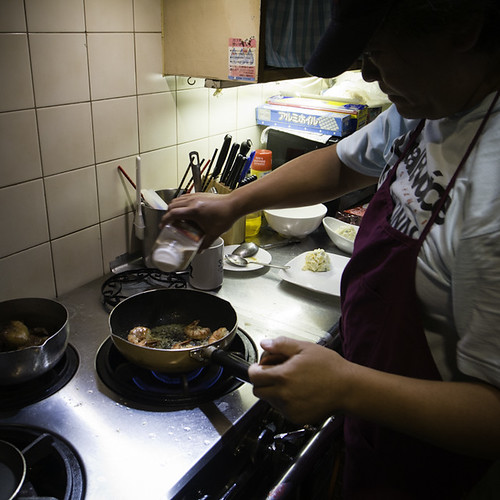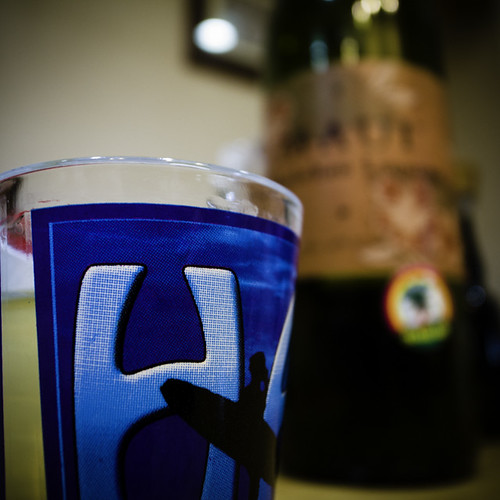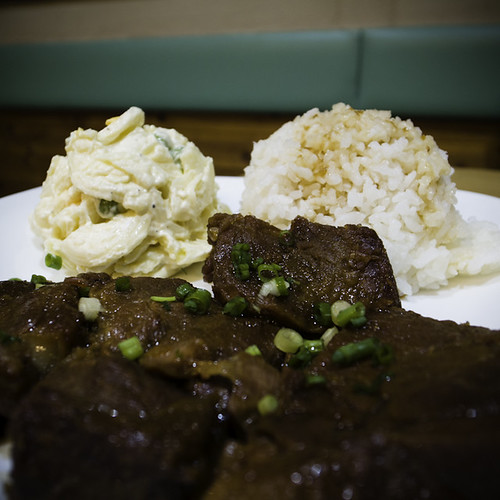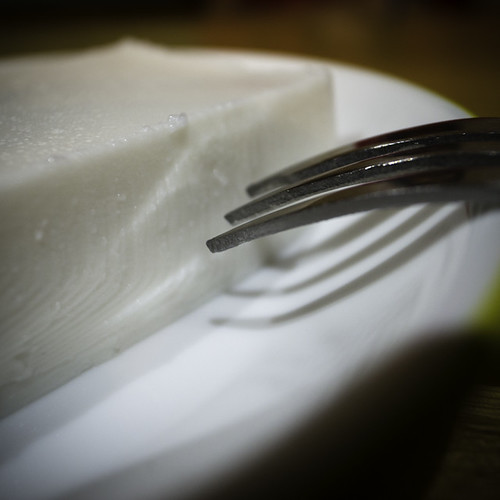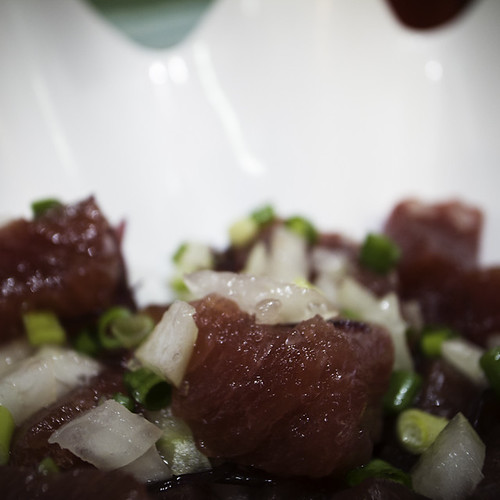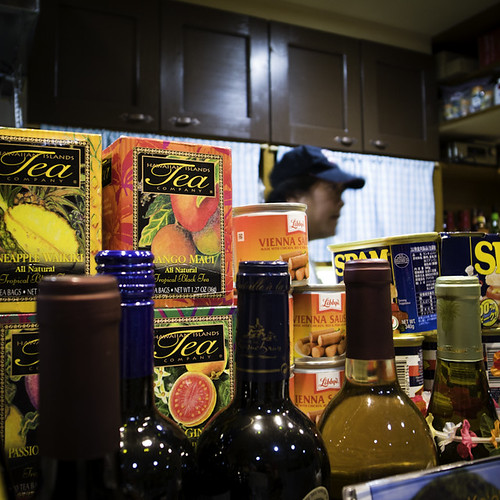Hawaiian, Local, American, and Soul Much More to Be Found in Sean’s Kitchen
Sean cooking up some garlic shrimp at Sean’s Kitchen.
The cool Hawaiian trade winds have breezed their way into the heart of the old part of Urayasu City Japan. Urayasu is just across the Kyo Edogawa River from me, and I spend a serious portion of my time there. This posting represents another Lucid Thoughts first. It is the first time that I have talked to a chef as artist.
Sean has a joyous easygoing soul. His delicious Hawaiian Soul food is a mixture of, Hawaiian, American and Local. All of his dishes are served in a comfy environment where customers are more guests than customers. He takes time to chat with all the guests and prepares all food to order.
So much love goes into his cooking, and the cooking warmed my wife and my heart. I started off the night with a shot glass of local Maui Okolehao [made from distilling the root of the Hawaiian Ti plant, back in the day it was a homemade moonshine]. It looked a bit like tequila, but had a sweeter aroma and finish.
shot glass full of the local liquor, Okolehao
First up was a tuna poke sprinkled with special Hawaiian Salt. My wife ordered the special of the day a shoy [soy suace] pork steak served with an Okinawan sweet marinade, a side of rice, and the most amazing side of macaroni potato salad I’ve had in decades. The flavors of the macaroni transported me back to picnicking with friends and family on Oahu. I asked Sean what was the secret to the salad, he replied that most places use the Japanese Kewpie Mayonnaise, but he uses Best Food’s Mayonnaise. It the mayonnaise that gives it the real Hawaiian flavor.
Shoyu Pork with a scoop of rice and amazing macaroni salad.
I had a fresh cesar salar with some roasted chicken. The salad was simple and tasty just like my next door neighbor would make. We delightfully munched on the treats and chatted with Sean about Hawaii and cooking.
For desert we had some homemade Haupia [Hawaiian style coconut jelly] that is traditionally made with Polynesian arrowroot. It was a refreshing dessert to cool off in Japan’s hot and humid summer.
Haupia, Hawaiian Coconut Jelly
It was a great dining and relaxing dining experience. We felt right at home as our ears were soothed with Hawaiian tunes, and our hearts were warmed with some honest home cooking.
The Daily Specials is where the magic happens at Sean’s Kitchen.
I caught up with Sean to ask him some lucid questions about his cooking life.
Aloha, Sean, Please introduce yourself to the lucid communication community.
Aloha, my name is Sean Shinshiro. I’m from Honolulu, Hawaii. I moved to Japan in 2004 as an English Teacher.
How did you first discover the joy of cooking?
I always loved cooking. It wasn’t until I moved to Japan that I realized how my cooking could impact people in a positive way. I started to cook for people from Hawaii that are living in Japan. Someone told me that my cooking was just like home and it makes living in Japan a lot easier. Someone also told me that when she’s homesick, she comes to my restaurant and feels much better. Making people happy gives me great joy in my job.
I usually ask what was a photographers first camera, what was the first dish that you could cook?
My first dish I cooked by myself was either mango bread or beef stew. It was so long ago, I don’t remember. I wouldn’t call PBJ, saimin [ed note: a Hawaiian style noodle soup, similar to Japanese ramen], tuna sandwich or hotdog cooking, but we grew up making these kinds of lunches and snacks.
Hawaiian cooking is a combination of Hawaiian, American, Japanese, Korean, Chinese, and Filipino. Am I missing anything?
Portuguese & Okinawan
How has the cultural mixing changed Hawaiian cuisine over the years?
Multi-Ethnic food started in the late 1800s / early 1900s on the sugar cane and pineapple plantations. Traditional ethnic ingredients were very scarce, so people were forced to improvise with ingredients from other countries. This was the start of what we call Local Food or Local Hawaiian Food. It has changed to the point where most people can’t identify the ethnicity of the dish. Multi-ethnic dish has expanded to include over half the world’s ingredients. Hawaii has restaurant categories such as Eurasian, Pacific Rim, etc.
Are there any secret spices or ingredients to Hawaiian cuisine? If so, what is your favorite?
Traditional Hawaiian spices are limited to only a few. Some of them are Hawaiian salt, Hawaiian chili peppers, Kukui nut, etc. I use them all. Traditional ethnic spices are what distinguishes the difference.
What do you want people to experience when they eat your cooking?
I want people to feel like they are in Hawaii, even if it’s just for a little while. I want them to experience the ethnic diversity and cuisine of the islands. I want foreigners to recharge their batteries at my restaurant to make living in Japan easier. I want to reduce homesickness. I want to share my culture with everyone that walks in the door.
Your restaurant specializes in Hawaiian, American and Local. What do you mean by local?
Local is not traditional Hawaiian food. I consider real Hawaiian food any dish that was pre-European contact (before Captain Cook.) Local dishes are mostly multi-ethnic that was concocted in Hawaii. Some of the most popular local dishes are Loco Moco, Spam musubi, etc.
How have you been supported by the Japanese and the Hawaiian communities in Japan?
I don’t have any budget to run a major advertisement promotion. I’ve been surviving on repeat customers and referrals from customers. I believe in the business philosophy that “The greatest compliment you can give a business is to refer a friend.” In this sense, both the Hawaiian and Japanese community has supported Sean’s Kitchen.
What is your most popular dishes?
1) Loco Moco
2) Daily Dessert Specials
3) Poki
4) Daily Specials
Tuna Poki
Your daily specials always sound so amazing. How do you decide on your daily specials?
In the beginning it was mostly to introduce Local food to the community. After a few weeks, Locals living in Japan requested specific dishes that you can’t find in Japan. On a few occasions, I was craving some local dishes. I’m at a point where Face Book has opened my restaurant to Japan and the requests for Local food specials keep coming in.
In America now there is the food truck phenomenon, you are currently selling your food at fairs and festivals in Japan. What do you like about doing the festivals?
I started out only selling Local and Hawaiian food at Hawaiian events and festivals in Japan. Sean’s Kitchen wasn’t supposed to be a restaurant. I intended it to be a kitchen where I could prepare all the food for Hawaiian events and festivals. The demand by Local Hawaii people craving local dishes was high enough that Sean’s Kitchen turned into a restaurant. I have food booths at most of the big Hawaiian events in Japan. I’ve also had food booths at the Urayasu City Matsuri [festival], Shin Urayasu Matsuri [festival], and some of the smaller events behind Urayasu Seiyu.
The best part about having Hawaiian food booths at festivals is watching how my cooking impacts people in a positive way. Some events, we serve over 400 dishes a day. In such a short period of time, so many people give me great feedback about how my cooking made them feel. Many Japanese comment about their good memories while vacationing in Hawaii. Many has also said my cooking is exactly like Hawaii and they want to revisit Hawaii again.
[editors note: this is exactly how I felt. Sean’s cooking, atmosphere, and energy all made me homesick for the Hawaii Islands. I wanted that island pace that only someone who has spent time on the islands can appreciate. I released a gigantic collective, sigh.]
Are there any new recopies you are working on?
Right now I’m not working on any new recipes. Most of the dishes I serve, I’ve made before moving to Japan. However, if any of my customers request something, I’ll be more than happy to try and satisfy them.
Where can the Lucid Communication community find out more about you and Sean’s Restaurant on the internet?
Right now Face Book is the best choice. You can like me at Sean’s Kitchen. I try to update it a couple times a week. I don’t know if anyone has written anything about my restaurant or about me on the Internet, but if you do find something, please send me the link. [editors note: there is also Sean’s Kitchen website.
Thanks so much for taking the time to talk with Lucid Communication.
Is there anything else you would like to say?
Sean’s Kitchen is not a fancy place. My portions are satisfying at a reasonable price. I like to think of it as a place where anyone living in Japan can come and hang out, make new friends, relax and have a good time. It’s a small cozy restaurant with Hawaiian atmosphere and music. I try my best to be flexible to accommodate any special requests from customers. I also try my best to cook as close to my grandmother’s cooking and favorite local Hawaii restaurants.
Mahlo Sean! Thank you so much for taking the time to talk about Sean’s Kitchen with the Lucid Communication community. I know for a lot of my Tokyo friends coming out to Urayasu is a bit of a trek, but the comfy island atmosphere is well worth it. Check Sean’s Kitchen Facebook page for the latest daily special. I never know what to expect from Sean on any given night.
check the map on directions to Sean’s Kitchen
Hawaiian Teas, Liquors, and Beers at Sean’s Kitchen
Sean’s Kitchen has some slightly irregular hours, Generally they are open on the following:
Dinner: 5:00 pm – 10:00 pm on Mon., Tues., Thurs., Fri.
Dinner: Saturdays 5:00 pm to 10:00 pmWe are closed every Wednesday, Sunday, & National Holidays
